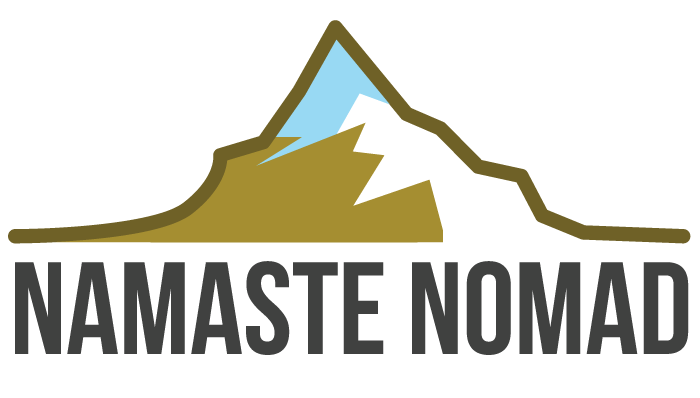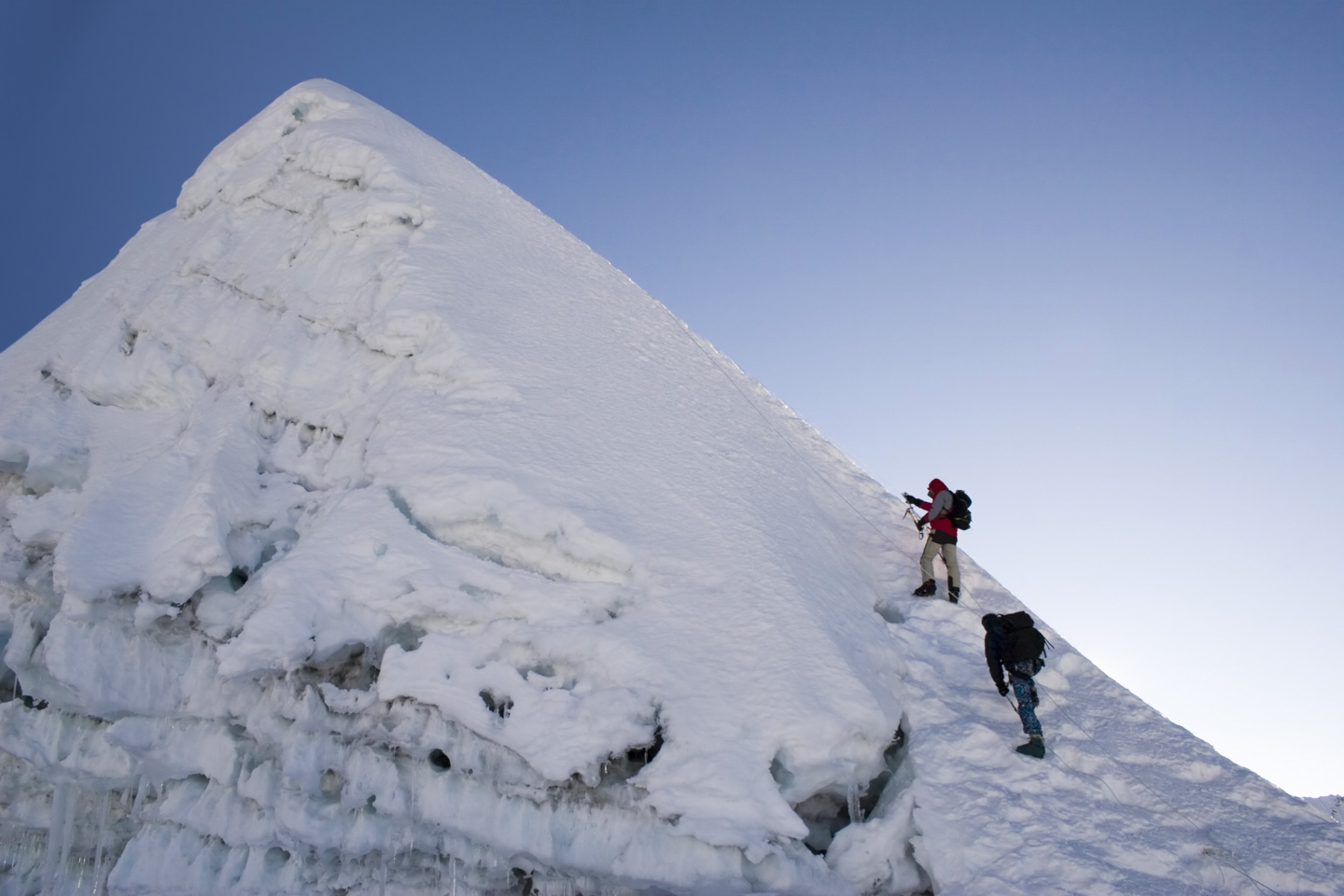€3,850 – €4,200
Island peak is one of the iconic climbing peaks in the Himalayas, yearly more than 300 people climb this peak. If you wish to experience peak climbing in the Himalayas then island peak is one of them to start with.
Island Peak is one of the iconic peaks in Himalayas, it is small in height but it not less exciting to climb than many other peaks in the Himalayas, if you are looking to climb bigger and higher peaks in future then, island peak should be you first attempt to understand and feel your strength. Namaste Nomad Organise yearly group expeditions to island peaks from Ireland, and we also organise for the independent groups, singles, couples, or just groups of friends from anywhere in the world. Every spring we take a group of climbers to island peaks for training before they aim for the higher peaks, such as Mighty Everest.
Island peak fully safe and very exciting climb, the last 300meter will give us a real feeling of climbing. The view from the top is incredible. Each year more than 300 groups attempt to scale the summit of Island Peak. It is the most sought after trekking destination because of its challenging geo-conditions. Although often classified as a trek, it involves a strenuous and challenging climb to its summit at 20,000 ft above sea level. Given its difficulty (alpine PD+) and accessibility, it is the most frequently climbed peak in the Himalayas.
Island Peak also known as Imja Tse, stands at 6,189 meters (20,305 ft) above sea level. The peak is actually an extension of the ridge coming down off the south end of Lhotse Shar. for taking part in this trip you have to have small bit of climbing experience, but not essential, as full equipment, guidance and support are provided by our team. We also give you one day training in base camp. We show you how to use rope, ice axe, crampons, ladder crossing skills. If you have good leave of fitness you will be safe and you can make it to top. First you have let go your attitude, you idintity, about who you are, be venerable and listen to your sherpa and leader and follow them entire journey. Sherpa and guides are there for you and they been there form many yeas doing same job and walking in to same condition many times, so definitely they know better than you on that condition. Trust them fully. After that no one can stop you to summit, online weather condition and your health.
Itinerary
Day 1: Kathmandu Arrival
Arrive in Kathmandu, transfer to hotel, evening dinner with a group briefing
Day 2: Half Day Sightseeing tour in Kathmandu
Sightseeing tour of the ancient Kathmandu city with its many beautiful temples and shopping courtyards. The major tourist attractions on this tour include a visit to the Hanuman Dhoka (Hanuman Gate) which takes its name from the Monkey God, Hanuman from the epic, Ramayana The palace of the Malla Kings located in the Hanuman Dhoka is of the 14th Century and it is still retained as a ceremonial palace of the present Shah dynasty. Important traditional Royal ceremonies including the coronation of the King of Nepal are still conducted at Hanuman Dhoka Palace. Near the Hanuman Dhoka is the house of the Living Goddess Kumari – Kumari Bahal. Two painted stone Lions stand guard at the entrance. Visitors may enter the courtyard to see the Living Goddess but are forbidden to take photographs. Also, visit Kasthamandap”, a temple built from the wood of a single tree from Where Kathmandu city derived its name. Continue drive to Swayambhunath Stupa – one of the protected monument sites of the Kathmandu Valley. It is situated on the top of the hill lying 4 kilometres west of Kathmandu. More than 2,500 years old, this ancient landmark is connected to the visit of Manjushree who created Kathmandu – a lake – by draining its waters. The sage saw a celestial lotus in bloom on the top of this hill and sacrificed it. It is an important pilgrimage centre as well as the centre of art, architecture, religion and culture of Mahayana Buddhism. Afternoon we rest and prepare for our trek the next morning.
Day 3: Kathmandu – Lukla – Phakding
Early morning transfer to the airport to fly to Lukla (2880m). This 45-minute flight provides a magnificent entry to the trek. It highlights the snowline of the Himalayan Range in the north and the rugged landing at the Lukla airport which is said to be one of the most spectacular flights in the world. Upon arrival, meet the Sherpa team and while the team reassembles the equipment for the distribution to the Porters OR Dzopke (a cross between and cow and a Yak used to carry loads) free time for tea/coffee. During this break, the guests are welcome to explore this bustling town on top of a hill with rows of houses, hotels and shops lining both sides of the cobbled street. The trek starts by following the trail leading in the northwest direction through the narrow street, which immediately descends from the end of the village on a trail through the open hillside. The trail is well defined and there are many shops and lodges catering to the trekkers. A new hanging bridge made last year about 100 meters long is what we cross at the beginning of the journey. From there we follow the regular trail passing small villages of Chaunri.
Day 4: Namche Bazaar
Leave the main village and follow the trail on the left bank of the Dudh Kosi River. It is a pleasant walk for the first half of the day as one passes through agricultural countryside, small wayside villages and a monastery. We cross the Dudh Kosi at Benkar where there are tantalizing glimpses of the snow peaks. Kusum Kanguru (6369m) and Thamserku (6623m). Just before lunch, there is a steep climb of about 20 minutes to arrive at Monjo for Lunch. After lunch, trek up to the check post to check the permits and enter the Sagarmatha National Park. Descend for 10 minutes and then cross a suspension bridge to arrive at Jorsale (2800m). Pass through several small villages and beautiful pine forests. This is a busy trail with plenty of human interest. Our first good views are of the west ridge of Kusum Kanguru (6339m). Follow the Dudh Kosi River, crossing a rickety suspension bridge, which is in a dilapidated condition, and then slowly climb up a very steep trail to Namche Bazaar. Near half waypoint, we enjoy our first views of Mt. Everest (8848m), Nuptse (7879m) and Lhotse (8383m) – the big three. The climb is for nearly 3 hours as one gain in altitude makes breathing difficult due to rarified air. Arrive at a gate with a sign saying, “Welcome to Namche Bazaar” but it is very misleading as it takes another 20 minutes to arrive at the main town. Upon arrival at Namche Bazaar (3447 m) check into the lodge. This prosperous town is the largest in Khumbu. Mt. Thamserku (6648 m) and Kwangde Ri (6624 m) loom along the east and west of the village. The sacred mountain Khumbila (5707 m) dominates the skyline along the west. Dinner and Overnight at the Lodge. Duration of Trek- 5 – 5 1⁄2 hours.
Day 5: Acclimatization day at Namche Bazaar
Today one can go around the town and see the busiest town in the Khumbu region. One can also go to see a small museum at the top of the hill in Namche. Dinner and Overnight at Namche Bazaar.
Day 6: Thyangboche
After breakfast visit, the checkpost, sign in your permits and start a short climb till we reach a big prayer stone. From here the path levels out with just few short climbs here and there. On the right side we get dramatic views of Amadablam (6696 m) and Kangtaige (6779 m) flanked by the towering view of the Sagarmatha (Everest), Lhotse and Nuptse. Descend through the rhododendron forest, watching for the blood pheasant and Imphayan pheasant in the undergrowth.
Descending down to Imja Khola (river) for a lunch stop at Phunki (3200m), next to several large water driven prayer wheels. The afternoon is spent climbing slowly on a steep trail to the Thyangboche Monastery and one of the most beautiful spots on earth. Thyangboche lies at the base of Kangtaiga and is a classic setting with superb views back up the valley to the Ama Dablam, and the Everest poking its southwest face over the huge ridgeline linking Nuptse and Lhotse. At the rear is the beautiful west face of the Thamserku (6608m) and Kang Taiga (6685m).
Day 7: Dingboche
After breakfast, set out on the trail with a short, steep descent through a forest of birch, conifer and rhododendron to the meadows of Devouche. Continue on a level trail through forests to arrive at a suspension bridge high above the fast-flowing Dudh Kosi river with fine views of Mt. Amadablam. Cross the suspension bridge and climb for another 10 minutes to arrive at a resting place.. Continue to climb till a pass and then there is a more gentle walk to the village of Tangboche(3985m) which also has a monastery. The monastery lies more on the route to Phortse and is not easily reached from the lower trail and for those who desire to visit the monastery, the trail bifurcates just before the village after the pass and a hard half-hour of climb up the ridge brings one to this fabled monastery. At the monastery is housed the Scalp of the Yeti which traveled the world in the 60’s. After lunch, pass through this village and take the right hand trail through the front yard of a few herders’ huts, over a stone wall. The landscape becomes very interesting as the vista opens before us and we can see the river flowing far down below as we take the trail that has been cut out along the sheer cliffs of rocks.Cross the bridge on a wooden bridge and from the bridge, it is uphill for about an hour till we reach Dingboche. Dinner and Overnight at the Lodge. Duration of Trek- 6 1⁄2 hours
Day 8: Rest and acclimatization at Dingboche
As per the study on high altitude sickness, it has been found that most people suffer or show signs of Acute Mountain Sickness (AMS) from the altitude of 141400 ft/ 4000 m. Thus it is highly recommended to have a rest day to acclimatize at this altitude before starting an ascent. From the lodge, in Dingboche, we head up through the village, following the Imja Khola Valley. The ascent is gradual, crossing small streams, through open alpine pastures with fine views of Island Peak at the head of the valley. We will reach the Chukhung lodge in time for lunch. After lunch, we walk back o Dingboche. Dinner and Overnight at the Lodge.
Day 9: Chhukung
Walk past the Dingboche village and after that, the trail becomes a gentle uphill as they say in Nepali “Nepali Flat”, till we reach Chhukung. Along the way, we have great views of Island Peak and the challenge that awaits us. Dinner and Overnight at the Lodge. Duration of Trek- 2 1⁄2 – 3 1⁄2 hours
Day 10: Paresya Gyab – Base Camp of Island Peak
Walk past the small village of Chhukung. As we walk we notice the change in the trek route as we start to see more rocks, stones and gravel on the way. The trek becomes tough not only because of the high altitude but also because of the roughness of the route. Dinner and Overnight at Camp Duration of Trek- 2 1⁄2 – 3 1⁄2 hours
Day 11: Attack Camp – High Camp
Dinner and Overnight Camp at Attack Camp.
Day 12: Summit Island Peak
Crossing the gully above the camp the trail makes a climb for another hour to a narrow ridge, leading onto the glacier. Here it is time to rope up and put on our crampons as the most interesting part of the climb begins with the glacier crossing. This is followed by the steep snow slope that leads onto the summit ridge. This ridge is wonderfully airy and on reaching the summit we have stunning close-up views of the south face of Lhotse looming over us whilst in the other direction, there are more dramatic mountain views. We descend along the same route, down to base camp. Dinner and Overnight at Base Camp.
Day 13: Contingency Day
Extra day in case of difficult weather conditions or other unforeseen circumstances. Dinner and Overnight at the Lodge/Camp.
Day 14: Dingboche
After breakfast set out backtracking on scattered rocks and jumbled moraines to return to Dingboche. Cross Chukkung on the way and climb over the ridge past Chortens and Main walls bringing us into the Chukung village and the prosperous village of Dingboche.
Dinner and Overnight at the Lodge. Duration of Trek- 3 1⁄2 hours
Day 15: Namche Bazaar via Thyangboche
Having been consistently at high altitudes above 4200m most trekkers welcome the thought of returning to warmer, softer climbs and the day’s walk to Thyangboche is a delightful way of doing so. The route starts back through the long walled paths of the Dingboche village, and a gradual ascent along the flanks of the hills below the village before a steep drop to the Dudh Koshi. A little further, the route joins the main trail coming from Pheriche. The route then passes through the village of Pangboche (3985m). Continue to backtrack and then descend to the spectacular little bridge over the Dudh Kosi river and head through the fir and rhododendron forest for a lovely afternoon’s walk to the meadows of Devouche. From here, there is a short climb before reaching Thyangboche for lunch. After lunch we retrace our steps down hill through the beautiful forest of juniper, rhododendron and fir to Phunk Tanga. After a short break we cross the Dudh Kosi, and ascend steeply to Trashinga. If going up was tough it is equally hard to get the footing and walk down hill. From here the trail contours high above the valley to Shanasa where Tibetan traders, resident in the area, have numerous ”artefacts” and worthwhile traditional souvenirs for sale. From Sanasa, head to the end of the village and then take the right hand trail which is a lovely easy trail to reach Namche Bazaar. Here we stop for lunch. After lunch heads towards the end of the bazaar and descend steeply to the river, cross the great bridge again, and then continue back to Jorsale where we leave the national park before continuing on to our lodge at Monjo where we will overnight.
Dinner and Overnight at the Lodge. Duration of Trek- 7~ 7 1⁄2 hours
Day 16: Lukla
It is interesting to watch others starting enthusiastically on the trek ahead as we head down to the village of Phakding. Today we retrace our steps along the Dudh Kosi, crossing to the western bank at Benkar. It is a beautiful and easy walk through blue pine and rhododendron forest, back-dropped with views of Kusum Kangaru. We will have lunch at Phakding and in the afternoon we ascend out of the river valley back to the airstrip and our lodge accommodation at Lukla. It is a delightful ending to the trip as one enters this busy village of Lukla. In the evening, a farewell dinner may be followed by a few celebratory drinks and dancing with our Sherpa companions
Overnight at Lukla. Duration of Trek- 5 1⁄2 ~ 6 hours
Day 17: Fly Lukla – Kathmandu
Early morning, fly from Lukla to Katmandu on a Twin Otter. Upon arrival, meet and transfer to the Hotel. The rest of the day is free to rest and relax. Overnight at the hotel.
Day 18: Final departure
Free for final minute packing and shopping until transfer to the airport for final departure.
Price includes
Price excludes
- International Travelling, and flight costs ( If mentioned on the website)
- Meals in Kathmandu
- Purchases of bottled water, gifts or alcohol (we supply boiled water for drinking)
- Entry visas for Nepal (suggest getting a 30-day tourist visa for Nepal on arrival into KTM)
- Personal clothing and equipment
- Personal expenses whilst trekking such as laundry, showers, internet use
- Personal travel/trip cancellation insurance
- Excess baggage charges for the flights to/from Lukla
- Any rescue costs
Tour enquiry
Reviews













